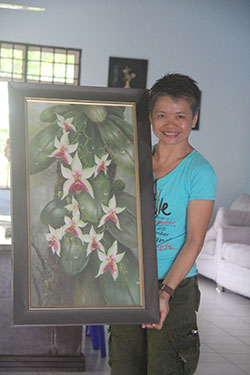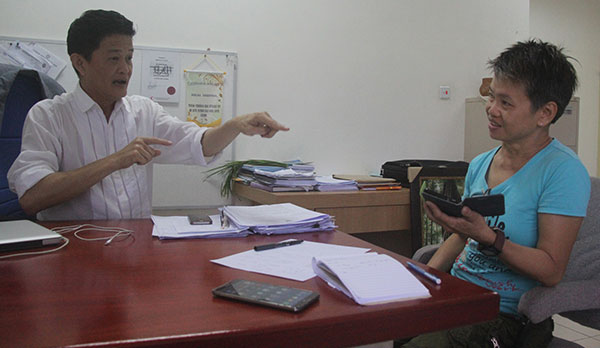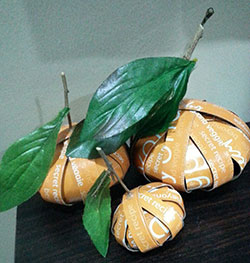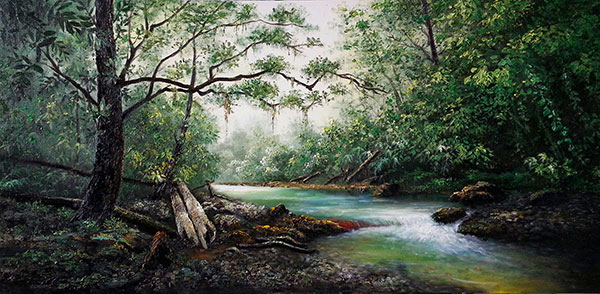
Yeo shows one of her paintings for sale at the SSD centre.
THE Malay proverb — diam-diam ubi berisi (literally translated as the tuber grows silently) — is often used to describe quiet individuals who are talented or skilled but do not trumpet their own praises, and because of that, others may not know of their substance under the surface.
Deaf artist Yeo Suh Chan fits that description perfectly.
The talented Sarawakian recently did the state and nation proud by bringing home the silver medal in the art painting category from the 9th International Abilympics Competition in Bordeaux, France.
Abilympics is a contraction of the words ‘abilities’ and ‘Olympics’. They are to skills competitions what Paralympics are to the Olympic Games and also an opportunity for people with disabilities to demonstrate their professional excellence in a competition setting.
Met at the Sarawak Society For The Deaf (SSD) recently, Yeo came across as shy and nervous at being the focus of any kind of attention.
“We’ve been trying to get her to hold an exhibition but she is quite a shy person. During the International Deaf Day when we had some stalls here to showcase and sell some of the crafts made by the deaf, we had to plead with her to set up a stall to sell her drawings and do some demonstrations. She is that shy. For her to have gone to France, that is wonderful,” said SSD CEO-principal Terence Ee, who agreed to be the sign language translator for Yeo’s interview with thesundaypost.
Humble beginnings
The 52-year old artist grew up in Kuching, the only daughter of a working class family and the eldest of four siblings. Her father worked small jobs in construction such as renovation and painting houses while her mother was a homemaker.
She attended the School for The Deaf at Batu Lintang from Primary 1 until Form 3.
When Yeo was an infant, she had a high fever, which led to her loss of hearing. As an adult, she doesn’t have any recollection of sounds she might have heard before losing her hearing but now she can sometimes hear extremely loud explosions of firecrackers.
She started drawing when she was about six or seven years old — with the encouragement of her father.
“He thought this was something I could do later in life and which I could also do from home, seeing my hearing disability,” Yeo signed as Ee translated for the benefit of thesundaypost.
Yeo soon realised she liked to draw, taking pictures from books, comics and photographs, and trying to sketch from them. She especially enjoyed drawing cartoons.
Yeo didn’t have a specific role model or someone to mentor her as she was growing up, painting whatever caught her interest. It was only sometime around 1986 that she turned her hand and eye to drawing elements of nature and landscapes, which have since become her forte.
Her preferred style of drawing and medium has changed over the years. She started mostly with sketches before moving to watercolour, then to oil and acrylic when she started drawing nature.
Her artistic flair also extends to other mediums but she indulges in them mainly for fun, including creating decorative items for festive occasions such as trees with paper leaves, fish out of angpow packets and oranges out of cardboard boxes for Chinese New Year. But her preferred medium is still very much drawing and painting. She gets inspiration from observing nature and her surroundings as well as from pictures and photographs.
“These days the computer and the Internet are a lot of help. Being able to take photos with my phone for reference is also useful,” the self-taught artist explained.
She started placing her artworks at her brother’s picture-framing shop. Customers would walk in, and seeing the beautiful paintings on display, purchase them. Over time, people began commissioning her to do pieces for them.
She doesn’t advertise, so she is unsure how people find out about her art. She thinks it might be through word of mouth or someone having seen her work somewhere.
Yeo takes about three days to finish a painting, depending on the size and complexity. Commissioned pieces take longer. Most of the paintings she creates and sells are of tropical landscapes and flora and fauna. Among her favourite subjects are orchids, nepenthes (tropical pitcher plants) of all the different shapes and varieties, and old buildings.
Ee said, when Yeo was younger, she was also a swimmer, representing the state in national competitions for people with disabilities, organised by the Welfare Department.
Yeo still swims regularly but to pass the time, she is also just as likely to be found somewhere around town with sketchpad and drawing tools close at hand, ready for duty should something catch her eye.
She is a long-time member of Urban Sketchers Kuching and a regular participant in their sketch-walks to various places where the group will do on-site drawings. Despite her natural shyness, she feels comfortable in the group as she is not the focus of attention since everyone gets to draw and shares a common passion.

Ee and Yeo communicate in sign language during the interview.
Competition experience
The Abilympics was a real eye-opener for Yeo as it was not only her first art competition but also her first time in Europe.
As is her usual practice, she packed her sketchpads and used it as a visual diary to document what she saw and experienced throughout the journey.
Yeo had to win the state and national level Abilympics in her category to compete in the finals in Bordeaux.
Before leaving for Europe, she was given the scope of the assignment — with requirements for the elements to be included in the pictures only being made known to the competitors at the competition venue.
What she conceptualised here, and what she did over there were quite different as she had to modify her designs and change her plans as the competition progressed.
The competition’s contemporary, surrealistic theme was especially challenging as it is quite different from her usual subjects and style. Competitors were also allocated a nerve-wrecking five hours to finish painting their competition entries.
“That was crazy – there’s no need to do things like that,” Yeo signed.
“That’s not how I do things. From start to finish, it was very stressful. First time I experienced that. As we were painting, the organisers would walk by every 30 minutes, holding signs to remind us how much time was left to complete our paintings. That was where all the stress came from,” she elaborated, her face expressing mock horror at the recollection of only having hours to complete a painting which would usually take her days to finish.
Nevertheless, the final results convinced the judges Yeo deserved second place for her efforts. She was able to incorporate many details that referred to her Sarawakian roots and the state’s native flora and fauna, with a majestic hornbill flying upwards into the sky as the focus of the painting.
She showed thesundaypost a photo she had taken of her prize-winning creation which she kept on her phone as she was unable to bring the actual painting back with her to Kuching as it is being kept in Kula Lumpur.
Nevertheless, the public can look forward to seeing Yeo’s other paintings at a two-day exhibition, where SSD is planning to showcase her artworks, and intricate handicrafts by Belinda Yii (a fellow deaf SSD member) at Vivacity Megamall on June 18 – 19.

Chinese New Year oranges made from cardboard boxes by Yeo.
Living in the present
Asked if she had ever given thought to how her life would be if she could hear, Yeo showed she is not one to dwell on the what-ifs or the might-have-beens, saying: “At this stage, if I was given the chance to hear and talk, I would say no because it means I have to learn everything from scratch. I am happy the way I am. I have learnt to accept it.”
When she was younger, did she ever feel it was unfair or experience anger over her deafness?
“A little bit, yes. Most people don’t know how to use sign language and there is a communication barrier with those who are hearing people. The frustration is there and I have to keep to myself a lot while people are talking around me. That’s the frustration and where communication breaks down,” she said.
She encouraged hearing people who want to communicate with people with hearing disabilities but who don’t know sign language to not be deterred by their feelings of shyness or awkwardness.
“The easiest way is to have a pen and paper and start writing. As you go along, you can write down a word and ask them how to sign it and learn the sign straightaway. If you cannot use sign language, just write.
“It can be awkward for hearing people to do that but if you interact with a deaf friend and you do it often enough, you will get used to it, instead of staying quiet and being embarrassed to express yourself because you feel shy,” she signed.
SSD holds sign language classes for the public. Yeo is one of their teachers and has been teaching the class since 2008.
As a parting question, thesundaypost asked her what she wanted people who can hear to know about deaf people.
“Deaf people have their language which is sign language, and this is how they communicate. They are not weird or abnormal. Hearing people can just talk. When we talk, we use facial expressions and hands – that’s how we are.
“This is our language — how we communicate. There is no such thing as you are normal and I am abnormal. We just communicate in different ways,” she signed.
Sign language classes are held every Monday and Wednesday from 7.30 to 9pm at the SSD centre located at Lorong Laksamana 8, off Jalan Laksamana Cheng Ho just behind the SIB Kuching church. Fees are RM60 per person for three months.
For more information about SSD and their activities and programmes, visit www.ssd.org.my or email them at [email protected]. They also can be contacted at 082-428260 or 082-428334 (fax).

Many of Yeo’s paintings are of tropical flora and fauna, including this one of Sarawak’s state flower — the Normah Orchid (Phalaenopsis bellina) – in oil.
